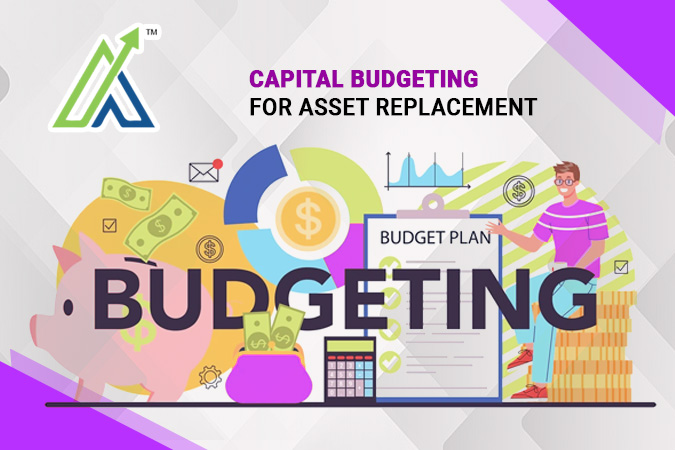Capital budgeting is the financial backbone of deciding whether to swap out old assets for new ones. This process, known as asset replacement analysis, digs into the costs and benefits of upgrading equipment, machinery, and infrastructure. Here’s a deep dive into the methods used and real-life examples to bring it all home.
Why Asset Replacement Analysis Matters?
Assets wear out—machines break down, technology becomes obsolete, and buildings deteriorate. To stay competitive, businesses must decide when to replace these assets. Capital budgeting techniques help weigh the financial pros and cons of such decisions, guiding companies towards smart investments.
Techniques for Evaluating Asset Replacement Projects
1. Net Present Value (NPV)
NPV crunches the numbers on cash flows—how much money comes in versus goes out over an asset’s life, adjusted for today’s value. A positive NPV means the project is likely to boost profits.
Example: Imagine a factory debating whether to replace an old machine. NPV calculations would show if the savings and revenue from the new machine outweigh its costs.
2. Internal Rate of Return (IRR)
IRR is the sweet spot—the rate where an investment breaks even. It tells you if the returns on a new asset beat the company’s cost of getting cash.
Example: A company looks at an IRR of 15% for a new project. If that’s higher than their cost of capital, it’s a winner.
3. Payback Period
How fast can you claw back your initial investment? The payback period gives a straight-up answer.
Example: A business buys a new truck for ₹10 lakh. If it makes ₹2 lakh a year in savings, the payback is 5 years (₹10 lakh / ₹2 lakh per year).
4. Profitability Index (PI)
PI takes a pulse on whether a project is worth its weight. A PI above 1 means the bucks you’ll get back outweigh the ones you put in.
Example: Say a project’s PI is 1.2. For every ₹1 spent, you’d get ₹1.20 back. That’s a solid investment.
5. Accounting Rate of Return (ARR)
ARR calculates the average yearly profit in relation to the initial investment. It’s simpler but doesn’t consider the time value of money.
Example: A machine costs ₹4 lakh and churns out ₹80,000 profit each year. ARR is a cool 20% (₹80,000 / ₹4 lakh).
Examples of Asset Replacement
- Manufacturing Sector
A factory flips the switch on outdate machines with newer models. The new tech promises faster production and lower upkeep costs. Using NPV and IRR, they figure out if the investment pays off over the new machines’ lifespan. - Construction Industry
A construction bigwig mulls replacing old bulldozers with greener, meaner models. They use payback period and PI to see if the upfront investment is worth it against future savings and efficiency gains.
Questions to understand your ability
Qus: What is the primary goal of capital budgeting for asset replacement?
- Determining historical costs
- Calculating annual depreciation
- Evaluating the financial feasibility of replacing old assets
- Preparing monthly financial statements
Qus: Which capital budgeting technique assesses how quickly an initial investment in asset replacement can be recouped?
- Net Present Value (NPV)
- Internal Rate of Return (IRR)
- Payback Period
- Profitability Index (PI)
Qus: What does Internal Rate of Return (IRR) signify about a project for asset replacement?
- The project’s profitability
- The payback period
- The annual depreciation rate
- The historical cost of the asset
Qus: Which method of capital budgeting calculates the present value of expected cash flows over an asset’s life?
- Payback Period
- Accounting Rate of Return (ARR)
- Profitability Index (PI)
- Net Present Value (NPV)
Qus: What does the Accounting Rate of Return (ARR) measure in capital budgeting for asset replacement?
- The average annual profit relative to the initial investment
- The inflation-adjusted cost of the asset
- The current market value of the asset
- The future cash flows from the asset
Conclusion
Capital budgeting isn’t just about bean counting—it’s about making smart choices that keep businesses ahead. By mastering NPV, IRR, payback period, PI, and ARR, companies can boldly navigate asset replacement decisions. These methods aren’t just about the numbers—they factor in tech upgrades, market moves, and staying strong in a competitive landscape.
In a world where change is the only constant, capital budgeting for asset replacement keeps businesses sharp, efficient, and ready for what’s next.
FAQ's
NPV crunches numbers to show if replacing an asset will bring in more cash than it costs, considering the time value of money and future cash flows.
The Payback Period simply tells how long it takes to recover the initial investment in new assets from the cash they generate—a shorter period often means better returns.
PI compares the value of expected cash inflows to the initial investment, giving a clear picture of whether a replacement project will be profitable enough.
IRR helps businesses decide by comparing potential returns from asset replacement with the cost of getting the money in the first place—it’s about seeing if it’s worth the investment.
ARR crunches numbers to figure out how much profit a new asset can bring in every year compared to what it costs upfront, making it a straightforward way to gauge its long-term financial punch.
In real-life situations like manufacturing and construction, you can see how NPV, IRR, and other methods steer businesses toward smart decisions on upgrading assets, ensuring they keep their edge and run smooth.

